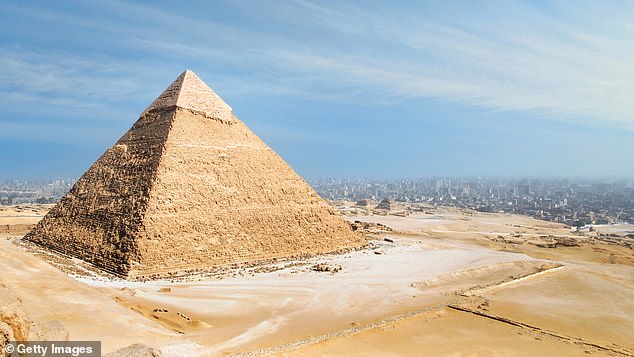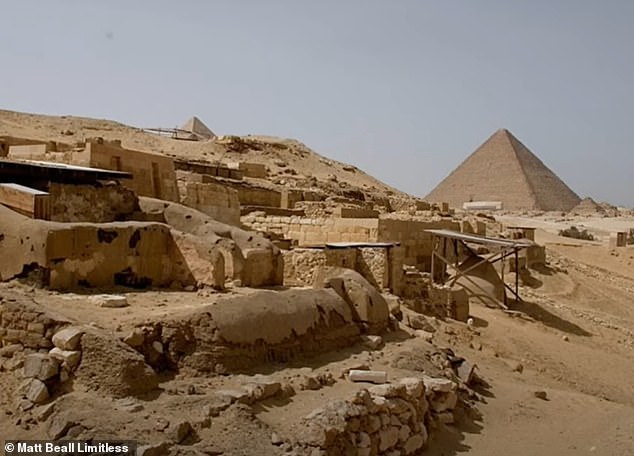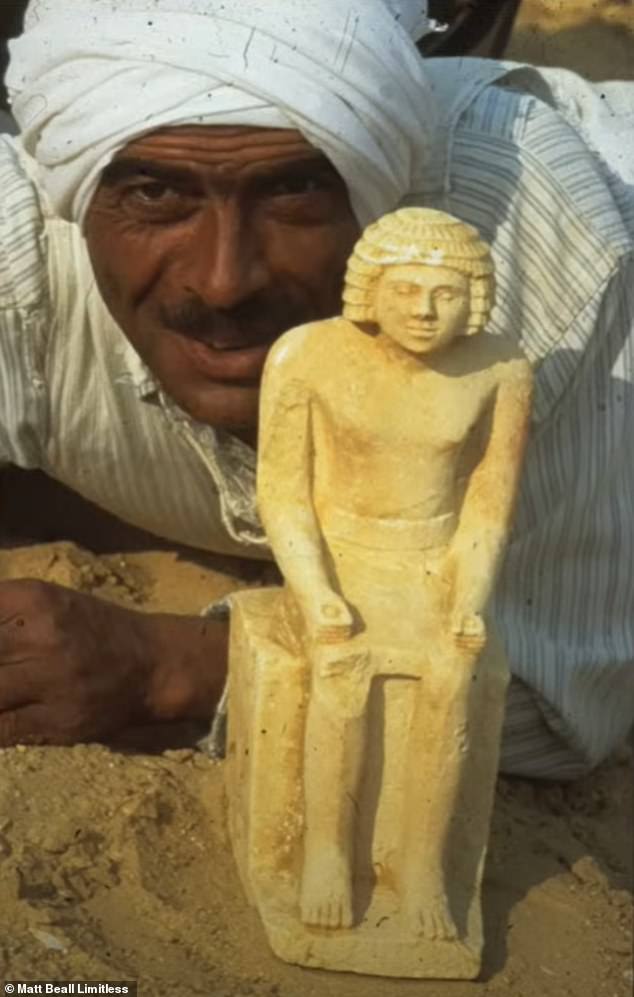Archaeologists have uncovered ancient inscriptions inside Egypt’s Great Pyramid that they say confirm who built the monument 4,500 years ago.
Egyptologist Dr Zahi Hawass and his team recently explored a series of narrow chambers above the King’s Chamber using imaging technology, finding never-before-seen markings left by work gangs from the 13th-century BC.
They also unearthed tombs south of the pyramid, the eternal resting places of skilled laborers, complete with statues of workers muscling stones and 21 hieroglyphic titles like ‘overseer of the side of the pyramid’ and ‘craftsman.’
‘[The discoveries] confirm that the builders were not slaves. If they had been, they would never have been buried in the shadow of the pyramids,’ Dr Hawass said during an episode of the Matt Beall Limitless podcast.
‘Slaves would not have prepared their tombs for eternity, like kings and queens did, inside these tombs.’
The idea that slaves built the pyramids traces back to the ancient Greek historian Herodotus, who wrote in 440 BC that 100,000 slaves worked in three-month shifts over 20 years.
The latest findings also shed light on how the pyramid was built, revealing that limestone from a quarry just 1,000 feet away was hauled to the site using a rubble-and-mud ramp, remnants of which were found southwest of the monument.
Dr Hawass is now working on a new expedition, funded by Beall, which will send a robot into the Great Pyramid’s ‘Big Void’, marking the first excavation of the structure in modern history.

The Great Pyramid of Giza is the largest Egyptian pyramid and was constructed by Pharaoh Khufu, who ruled during the Fourth Dynasty of the Old Kingdom

Egyptologist Dr Zahi Hawass shared the discoveries on the Matt Beall Limitless podcast this month
The Great Pyramid of Giza is the largest Egyptian pyramid and was constructed by Pharaoh Khufu, who ruled during the Fourth Dynasty of the Old Kingdom.
It is also one of three within the Giza plateau, the other two include the Pyramid of Khafre and the Pyramid of Menkaure, as well as the Great Sphinx.
All shrouded in mystery due to their unclear construction methods, precise astronomical alignment and still-debated purpose.
Inscriptions were previously found inside the Great Pyramid during the 19th century, sparking debate that the writings were forged hundreds of years after it was built.
‘There was some debate on whether or not that could be a forgery, but now you’re saying that you’ve discovered three more cartes within the King’s Chamber,’ Beall asked Dr Hawass.
The archaeologist then showed images never shared with the public, highlighting the names drawn onto the rock.
‘They were found in chambers that are difficult and dangerous to access, and they use writing styles that only trained Egyptologists can accurately interpret,’ said Dr Hawass.
‘It’s nearly impossible that someone in recent times could have forged something like this. You must climb about 45 feet and crawl through tight spaces to even reach those chambers.’

Egyptologist Dr Zahi Hawass and his team recently explored a series of narrow chambers above the King’s Chamber using imaging technology, finding never-before-seen markings left by work gangs from the 13th-century BC

Hawass’s team also unearthed tombs south of the pyramid, the eternal resting places of skilled laborers
The archaeologist admitted that some European visitors managed to enter and left their names scratched into the stone in the late 18th and 19th centuries.
‘But the inscriptions we found are clearly much older, original graffiti from ancient Egyptian workers,’ Dr Hawass added.
Alongside these inscriptions, the second major discovery was the tombs of the pyramid builders.
Dr Hawass and his team found tools inside the tombs, such as flint tools and pounding stones that would have been used in the Great Pyramid’s construction.
‘The base of the Great Pyramid is made from solid bedrock, carved 28 feet deep into the ground,’ he said.
‘This means that after marking the square base, the builders cut down into all four sides of the rock until they created a level platform of solid stone, no blocks, just bedrock.
‘You can still see this today on the south side of Khufu’s pyramid.’
He continued to explain that the workers operated in teams, some cut the stones, others shaped them and the rest transported the material using wooden sleds pulled over the sand.’
He added that the rocks were then moved using ramps, which the archaeologist said he found evidence of.

Hawass’s team also unearthed tombs south of the pyramid, the eternal resting places of skilled laborers, complete with statues of workers muscling stones
‘The ramp had to come from the southwest corner of the pyramid and connect to the quarry,’ said Dr Hawass,
‘We excavated this area, and in the site labeled C2, we found remnants of the ramp, stone rubble mixed with sand and mud. When the ramp was dismantled, they didn’t remove every trace, and what was left behind is what we uncovered.’
The conversation switched to the upcoming exploration of the Big Void, which Dr Hawass is leading.
‘I am funding the exploration of the Big Void,’ Beall said, adding that he is helping the team build the robot for the mission.
The podcaster explained that they were working on a robot, no larger than a centimeter, which will travel through a tiny hole drilled into the side of the Great Pyramid.
The Big Void, discovered in 2017, stretches for at least 100 feet above the Grand Gallery, an ascending corridor that links the Queen’s chamber to the King’s in the heart of the pyramid.
Dr Hawass believes he will locate the lost tomb of Khufu inside the void.
‘I think it’s unlikely that it’s a tomb, just because there’s never been a tomb,’ Beall said.
‘There’s never been a Pharaoh discovered in any of these in any of the main pyramids ever.’
The excavation is slated for around January or February next year.











